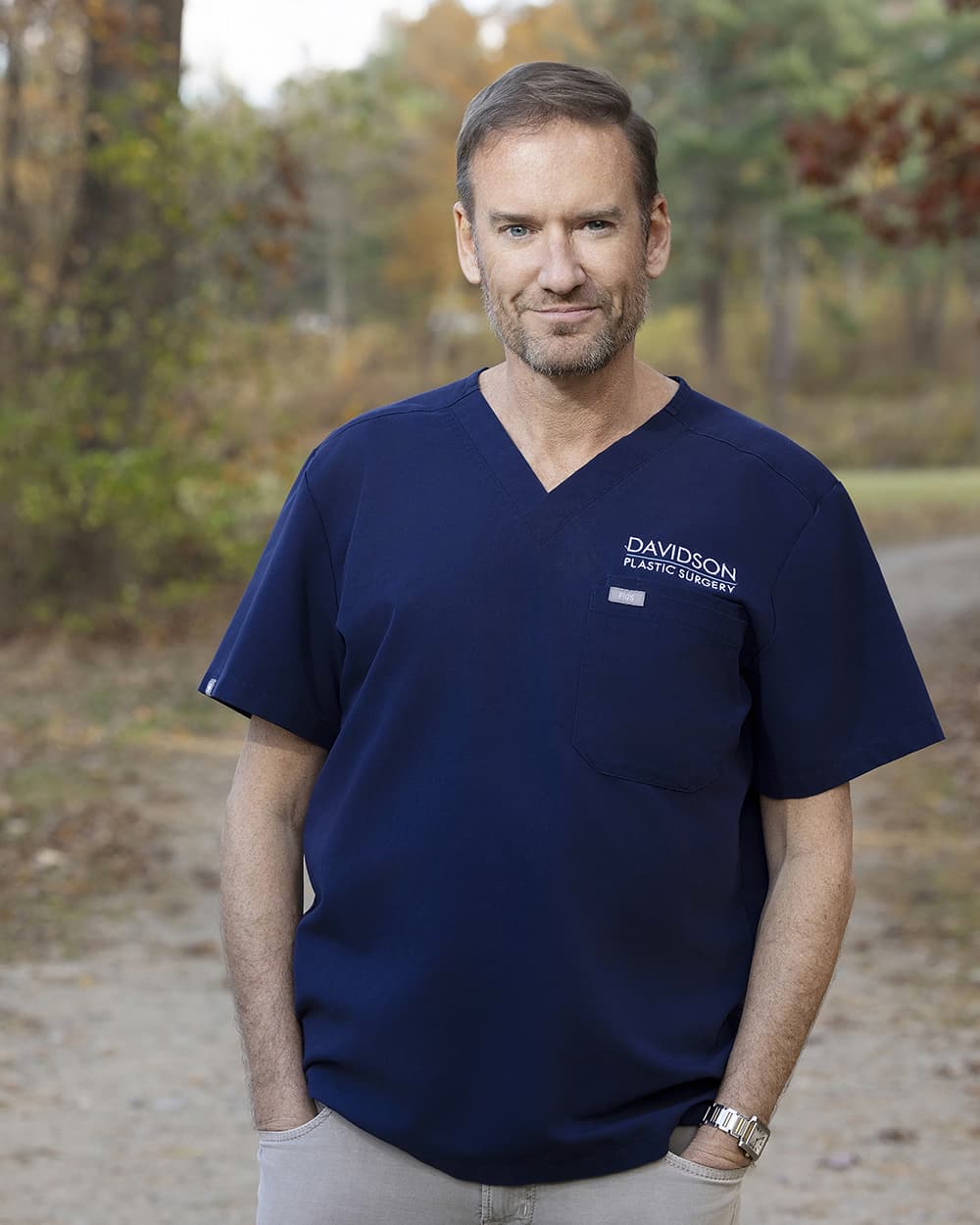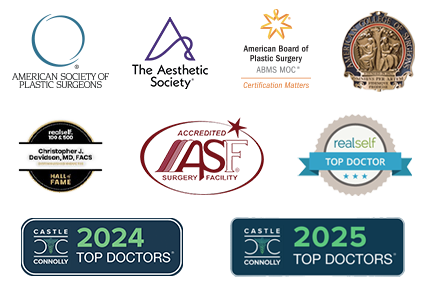Christopher J. Davidson, MD
Fraser Medical Building
332 Washington Street, Suite 100
Wellesley, MA 02481
Phone: (781) 237-7700
Monday–Friday: 9 a.m.–5 p.m.
The eyes are one of the most prominent features of the face. They express emotion, balance the appearance, and contribute to an overall sense of beauty. The eyes, however, are one of the first places to show signs of aging. Sagging tissue of the upper eyelids or fine lines under the eyes can make the face look tired, frustrated, unhealthy, and even years older. While the normal aging process is primarily responsible for these changes around the eyes, other factors may compound the issue, as well. Sun damage, smoking, illness, and genetics can accelerate the development of lax, wrinkled tissue, which is why many people visit Dr. Christopher Davidson for eyelid surgery from Boston and its western suburbs, including Wellesley, Framingham, Newton, and Natick, Massachusetts; Providence, RI; southern New Hampshire; and southern Vermont.
The upper and lower lid blepharoplasty, also known as an eyelid lift, are surgical procedures designed to reduce lax, drooping skin around the eyelids, restoring a youthful appearance. The surgical procedure will also dramatically reduce the fat pads of the upper and lower eyelid, providing patients a well-rested, refreshed look.
The eyelid surgery can be performed on the upper eyelid or lower eyelid alone, or they can be combined into one procedure. Many people will choose to combine the eyelid lift with the facelift for optimal facial rejuvenation. Dr. Davidson has been performing the eyelid lift for almost 15 years. His extensive experience and meticulous attention to detail make him a very sought after plastic surgeon.
Eyelid surgery is a growing trend in the Asian community, as many people come to understand the benefits of the procedure. By altering the shape and contour of the eyes, Dr. Davidson is able to provide a more Westernized appearance. While making the eyes bigger and rounder, as well as the eyelid crease more prominent, Dr. Davidson also takes care to preserve each patient’s ethnic or racial heritage.
Anyone frustrated with lax tissue along the upper or lower eyelid may benefit from eyelid surgery. The ideal patient will be in overall good health, have a clear understanding of the eyelid surgery procedure, and hold realistic expectations for their results. People with specific medical conditions, such as certain thyroid disorders or chronic dry eye, may be encouraged to postpone their blepharoplasty. At the eyelid surgery consultation, Dr. Davidson will determine if an eyelid lift is right for an individual’s unique needs.
Prior to committing to an eyelid lift, a one–on–one consultation with Dr. Davidson will be scheduled. During this appointment, he will perform a brief exam of the facial anatomy, review the medical history, and discuss all current medications. He will also listen to the patient’s aesthetic goals and desires. Dr. Davidson will then explain the various options, both surgical and noninvasive, that are available to restore more youthful looking eyes. If he determines that eyelid surgery would be the most appropriate procedure for the specific patient, an individualized surgical plan will be created. At this time, the exact cost of the eyelid surgery will be determined and the payment plans reviewed.


Dr. Christopher Davidson's patient first approach to aesthetic medicine means that every decision he makes is aimed at achieving the optimal outcome for the patient. This is apparent, not just in the beautiful, natural-looking results he creates, but also in the compassionate care he delivers through every step of the process.


Dr. Davidson performs the blepharoplasty as an outpatient procedure, under IV sedation. The eyelid surgery will take between one and three hours to complete, depending on the extent of correction required. Dr. Davidson will tailor the eyelid surgery procedure to the specific needs of the patient, performing an upper lid lift, lower lid lift, or a combination eyelid surgery.
Over the years, the paper-thin tissue of the upper eyelid can lose its elasticity and resistance, sinking downward over the eyes. Not only will this droop make the face appear unhappy or exhausted, the sagging, heavy tissue may even impair eyesight. An upper lid blepharoplasty is designed to remove this unsightly, stretched tissue from the eyelid, restoring a refreshed appearance.
To begin the upper lid blepharoplasty, Dr. Davidson will make a very small incision along the upper eyelid crease. From here, he will remove the excess skin and fatty tissue. Finally, Dr. Davidson will smooth the remaining muscle and skin, pulling them taut. Once the correction is complete, sutures are placed for proper healing.
As the face ages, the fatty tissue below the eyes will start to sink and pull away, eventually resulting in dark circles or “bags” under the eyes. The lower eyelid lift will remove the excess tissue under the eyes and redistribute the remaining fat, eliminating puffiness. Volume can also be added under the eye and along the upper cheek to restore healthy facial contours.
Dr. Davidson begins the lower lid blepharoplasty by making a small incision inside the lower eyelid, or underneath the lower lash line. From here, he will carefully remove the excess fatty tissue from under the eye and excise loose skin. The remaining tissue will be lifted, the muscles tightened, and the skin pulled smooth. Once the desired correction is complete, Dr. Davidson will place sutures to allow for appropriate healing.
Patients should expect their eyelid surgery recovery to take between seven and 14 days. Initially, mild bruising and swelling may be seen, diminishing over the first several weeks. While patients note only minimal pain, the eyes may feel tight and sore. Dr. Davidson will prescribe appropriate medications to keep patients resting comfortably during their recovery.
At the first follow-up appointment, approximately five days after eyelid surgery, Dr. Davidson will remove any sutures. Within five to 10 days, patients are generally feeling well enough to return to work or school. Patients should avoid straining, bending, and lifting during the early postoperative period. Vigorous activity and strenuous exercise should be postponed for four to six weeks; however, light activities can be resumed in five to seven days. Scarring will slowly fade to a thin, almost invisible white line.
Blepharoplasty is an extremely safe and effective procedure when performed by an experienced cosmetic surgeon. As an invasive procedure, eyelid surgery will always carry the small chance for complications to occur. These can include hematoma, bleeding, infection, scarring, ectropion, and blindness. Dr. Davidson is board certified by the American Board of Plastic Surgery; he consistently performs the safest and most successful eyelid surgery available.
Blepharoplasty, also known as an eyelid lift, is a surgical procedure designed to eliminate excess, drooping skin or fullness in the upper eyelids, as well as puffiness along the lower lid. The procedure may be performed on the upper or lower eyelids, or a combination of both.
Anyone looking to improve the appearance of aging eyes may make a good candidate for this procedure.
During the Blepharoplasty consultation, Dr. Davidson will perform an examination of the tissue surrounding the eyes, review the medical history, and any current medications. He will also explain the procedure in detail. At this time, it will be decided if an Eyelid Lift is right for the individual patient.
Depending on the extent of correction required, Dr. Davidson may use sedation, local anesthesia, or general anesthesia during the procedure.
For the upper lid blepharoplasty, Dr. Davidson will make small incisions along the crease of the upper eyelid. Excess muscle and fat are then removed. For the lower lid blepharoplasty, a tiny incision will be made within the eyelid or immediately under the lower lash line. From here, fat may be removed and the tissue repositioned to restore healthy, bright appearance.
Dr. Davidson’s blepharoplasty usually takes between one to three hours to complete.
While scarring does occur after blepharoplasty, these tend to be very small and well concealed within the natural eyelid’s contours. Scarring will also fade slightly over time.
Patients may experience mild discomfort after a blepharoplasty. The lids may also seem tight or sore. Dr. Davidson will prescribe the necessary pain medications to keep patients healing comfortably after the procedure.
The recovery period after eyelid surgery will take approximately one week. Bruising and swelling are common, but these will normally diminish in five to 10 days.
After eyelid surgery, patients usually feel well enough to return to work in five to seven days.
One week after a blepharoplasty, light exercise can usually be resumed. However, vigorous activities and exercise will need to be postponed for the next four weeks.
The results from a blepharoplasty are permanent. Over time, as the normal aging process continues, the results may alter slightly.
Eyelid surgery is considered a safe procedure, however complications can occur. These may include asymmetry, swelling, ectropion, dry eyes, insufficient eye closure, and lid malposition.
As we age, our faces can look more tired and weathered. As the elasticity in our skin decreases, it is possible to develop drooping and sometimes puffy eyelids. Often, patients who are concerned by their perpetually tired look can enjoy a more rejuvenated appearance after an eyelid surgery. Also known as a blepharoplasty, an eyelift removes fat deposits, excess skin, or both skin and fat to improve the appearance of the eyes. While eyelid surgery is primarily used to improve the cosmetic appearance of the eyes, it may also serve as a functional purpose in older persons where the vision range may be limited by extensive sagging skin above the eyes.
Eyelid surgery may be performed on the upper eyelid, the lower eyelid, or both. During your consultation, Dr. Davidson will determine whether excess skin, fat is causing the unsatisfactory appearance of your lids, and whether upper, lower, or a combination of the two blepharoplasties is in order.
Dr. Davidson takes great care in ensuring that the eyelid surgery incision lines are well hidden within natural skin folds above and below the eye. Natural-looking results are the main goal, as no one likes that fake, odd-looking result.
Prior to the procedure, Dr. Davidson may inject a local anesthetic to numb area, and an intravenous sedative may also be administered. Then he will remove a small, crescent-shaped section of eyelid skin. He may also remove small pockets of extra fat within the eyelids. The incision is then closed by stitches.
For those eyelid surgery patients who are primarily concerned with excess fat under their eyes, Dr. Davidson may recommend a transconjunctival blepharoplasty. Here, instead of making an incision on the skin of the eyelid, he will make a cut through the inner surface of the lid, removing fat deposits through the small incision. The advantage of this form of eyelid surgery is that there are no visible scars.
Before you undergo eyelid surgery, Dr. Davidson will meet with you to discuss your goals and expectations, as well as assess your medical history to see whether you are a good candidate for this procedure. He may ask regarding a history of thyroid disease, hypertension, or eye problems, as they may increase the complications risk.
Before surgery, he will discuss with you the results that can be expected and the possibility of rare but potential problems that may occur. As with any type of cosmetic surgery, it is important that an eyelid surgery patient has realistic expectations. Although a blepharoplasty may improve the eyelid’s appearance, other procedures may also be needed to reduce wrinkles from appearing around the eyes or to address other signs of aging. You may also be asked to stop smoking and abstain from aspirin two weeks before and after the blepharoplasty.
After blepharoplasty, an antibiotic ointment may be applied to the suture line each day for several days. The patient may also require an antibiotic several times a day for preventing infection. To reduce swelling, ice-cold compresses may be applied to the eyes for first days following eyelid surgery. Some swelling and discoloration is initially expected around the eyes. The stitches may be removed within a few days after the procedure, and the patient may return to normal activities within seven to 10 days.
Talk to Dr. Christopher J. Davidson to learn more about eyelid surgery in Boston. Call (781) 237-7700 or request a consultation.